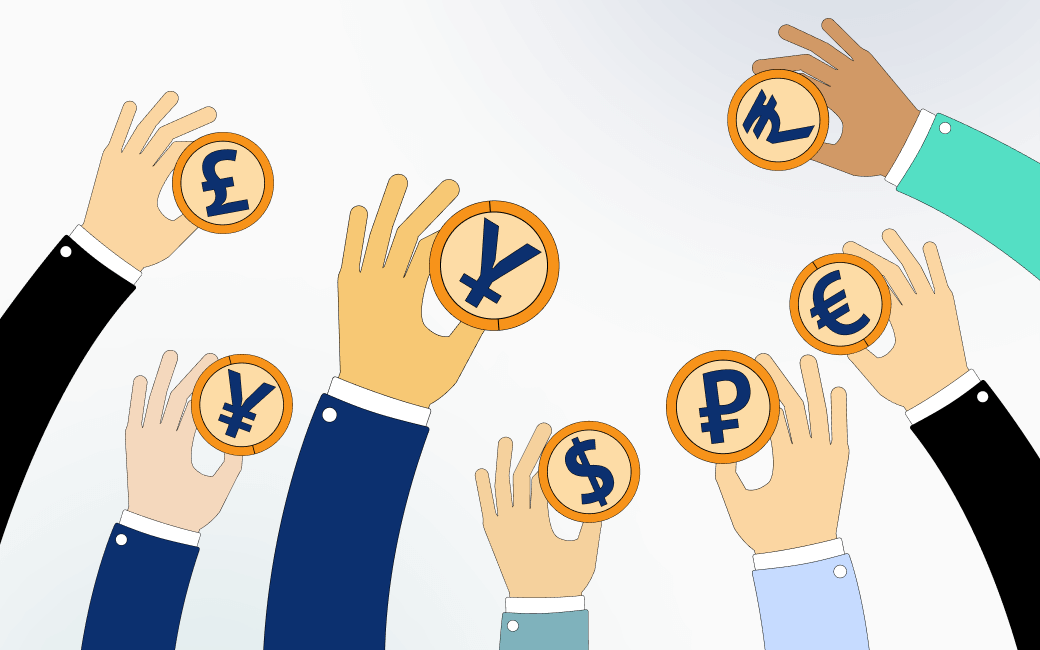Introduction
If you want to know how to trade currency like a professional, you need to understand some of the concepts surrounding trading currencies.
After learning how the forex market works, it will help you get an idea of the different market forces that can affect the price of the currencies you may want to trade.
By combining this with some knowledge about chart indicators, helpful trading tips, and an excellent trading platform, you will be in a better position to make money trading currencies. Don’t put yourself under pressure to learn everything too quickly. You’ll need to keep a cool head in the trading world!
What is Currency Trading?
Forex (“foreign exchange”) is the world’s largest asset market, but about twenty currency pairs make up most of this. A “currency pair” is two currencies that are being traded against one another. Instead of investing in a single currency going up or down, currencies come in pairs, so to invest against one, you will need to invest on its partner.
For example, GBP (Great Britain Pound) versus US Dollar is a prominent currency pair. If you believe the dollar will rise against the pound, then you can invest in the dollar. Naturally, you will need to investigate the market factors behind both currencies (to make sure the pound’s price will not rise more).
The change in price between currency pairs is measured in “pips”, which stands for “price interest point” or “percentage in point”. Pips are one-hundredth of one per cent (or four decimal places) of the relative change in value between currencies.
The “spread cost” (the difference between the bid and ask prices) is also measured in pips. It’s essential to factor the spread into your calculations, and some brokers will add commission by increasing the spread price.

What Are the Market Forces Behind Currency Pairs?
Here are six examples of factors that influence the price of currency pairs. Understanding these forces is key to forming a fundamental analysis of any currency pair.
- The stock markets
The stock market can be a valuable indicator for the forex market. If the stock market from a particular country is performing poorly, this usually means the currency prices will be low as well.
- Political landscape
If the political conditions within a country or region are unstable, it is difficult for the economy to grow. Conversely, if there is a stable government, the economy can flourish, and the currencies price will increase.
- Economic planning
Researching the fiscal policy of a nation can be very revealing. Finding out whether a country has an investment-friendly policy will give you an unambiguous indication of whether foreign currencies will be exchanged for their own, thus increasing the currency’s value.
- Employment figures
If a country has high unemployment figures, it means the economy is growing slower than the rate of people able to work. A slow-growing economy has a negative knock-on effect on currency prices.
- Inflation rates
A low inflation rate is a positive economic signal for the future as inflation decreases a currency’s value. An inflation rate of around 2% and under is good in most cases.
- Interest rates
Raising interest rates is a method the banks use to slow the rate of inflation. An increase in the interest rate could mean an increase in the currency value as it will return more yield if deposited.
There are many other forces, including trade terms (import vs export prices), government debt, and speculation. The greater your understanding of market forces acting upon currency pairs, the more accurate your price predictions will be. Used in combination with technical indicators, this sort of information can provide you with an excellent basis for your trading decisions.

Top Tips: How to Trade Forex
- Understand yourself
There are two critical questions that newbie traders should ask themselves. The first is, ‘What sort of trader would I like to be?’. From scalper and day trader to short-term and long-term investor, several practical and strategical differences between trader types need to be established.
The second question to ask is, ‘What is my risk tolerance?’. Risk tolerance is often established on a scale of 1 – 10. Knowing how much of a risk you are happy to make will help you create your trading strategy.
- Create a strategy
By creating a trading strategy, you will avoid making on-the-spot emotional decisions. Ensure all your trades are part of an overall plan that accounts for losses and gains. Keep track of your spending and profits.
Repeat the details of your plan which are working and adapt or stop the aspects which are not. A winning strategy can take a while to perfect, but you can avoid many pitfalls with a bit of learning and practice.
- Practice with paper trading
Before trading with real money, practice with what you know for free. This can be done using a demo account account on an online trading platform. Alternatively, you can do it yourself by writing down your hypothetical investments on a bit of paper and seeing how you go.
- Learn, learn, learn
When you stop learning, you stop getting better. It’s as simple as that. Stay open to learning new things, and you will likely become a much more profitable trader.
- Analyze the currencies
Guessing is just giving away any edge you could have. With careful technical and fundamental analysis, then, statistically speaking, you will be putting yourself in a much better position. The technical analysis encompasses all chart indicators techniques (Bollinger Bands, MACD and Stochastics). Fundamental analysis refers to all economic market events that could affect the currency pair you are interested in trading.
- Don’t get greedy
A poor analysis is rarely the cause of significant losses. Bad risk management and a lack of emotional control are usually to blame. One of the most challenging emotions to contend with is greed. Unfortunately, traders tend to get greedy when a currency is booming (shortly before a fall). The time to be greedy, it is often said, is when the market’s fear index is high and prices are low.
- Use stop loss and take profit
As part of your trading plan, you should establish the exit points in advance, both to take profits and to cut losses. Work out, in advance, at what price you would like to take profit and at what level it is convenient to set a stop-loss. A stop-loss is an order to close your trade when the price moves in the opposite direction you expected. These losses can be factored into your overall trading plan

Which is the Best Currency Trading Platform?
One final tip: find the right forex trading platform. Nowadays, there are many brokerages to choose from, but it can be hard to separate the wheat from the chaff. At “TradeOr”, we can offer a wide variety of marketplaces, features and functionality to give you an unparalleled trading experience. We can also provide you with multiple trading assets, such as Forex, Cryptos, Metals, and Commodities. We have highly competitive rates with zero commissions on all trades. If you want to find out more or have any other questions, please don’t hesitate to get in contact with our friendly support team, available 24/7.

Conclusion
Learning how to trade currency may seem daunting, but if you follow some time-tested trading advice, you will soon be trading like a pro! After understanding the fundamental concepts behind forex trading, the market forces and some of the well-known trading tips to follow, you will be ready to trade currencies for real.
You will, of course, also need to choose a currency trading platform carefully. We highly recommend our online broker, TradeOr, for many reasons, such as zero commission fees when opening a trade and our high leverage rates on a variety of trading assets. However, to find out exactly why, you need to see and experience TradeOr for yourself. Our fantastic support team will be able to answer any questions you may have!
FAQ
- What Is Currency Trading?
Currency trading on the forex market comprises around several currency pairs. A currency pair is two currencies, and traders can benefit from fluctuations in the price of a currency pair. "Pips" are used to denote the relative change in value between the two currencies in a pair and also to measure the spread, which is the gap between the bid and the ask prices of a currency pair.
- What Affects The Price Of Currency Pairs?
There are myriad factors that affect the price of currency pairs. These factors include stock markets, political landscape, economic planning, employment figures, inflation rates, interest rates, terms of trade, government debt and speculation.
- How To Trade Currency Tips?
Some well-known currency trading tips are understanding yourself (your trader type and risk tolerance), creating a strategy, practising with paper trading, learning, currency analysis, avoiding greedy decisions and using stop-losses. Choosing a decent, reputable broker is also essential.
- Should I Set Up A Stop-Loss?
Setting up a stop-loss is regarded as fundamental to every forex trading plan. A stop-loss gives you control over any potential losses. With an effective trading plan, your losses can be kept smaller than your profits.
- Which Is The Best Currency Trading Broker?
We hope you consider our trading platform, TradeOr, in your hunt for the best currency trading broker. We have a fantastic range of marketplaces, trading features and functionality, as well as zero commission fees and high leverage rates on trades. You can easily contact our customer service team 24/7 if you have any questions.